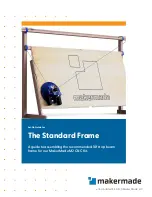
www.scheppach.com
+(49)-08223-4002-99
+(49)-08223-4002-58
22 І 80
•
Cracks due to the insulation ageing.
Such damaged electrical connection cables must not
be used and are life-threatening due to the insulation
damage.
Check the electrical connection cables for damage regu-
larly. Make sure that the connection cable does not hang
on the power network during the inspection.
Electrical connection cables must comply with the ap
-
plicable VDE and DIN provisions. Only use connection
cables with the marking „H05VV-F“.
The printing of the type designation on the connection
cable is mandatory.
AC motor
•
The mains voltage must be 230 V~
•
Extension cables up to 25 m long must have a
cross-section of 1.5 mm
2
.
Connections and repairs of electrical equipment may
only be carried out by an electrician.
Please provide the following information in the event of
any enquiries:
Type of current for the motor
•
Machine data - type plate
•
Machine data - type plate
Cleaning and Servicing
Pull the mains plug before any adjustments,
maintenance or repair.
m
Have any work on the device that is not de
-
scribed in this instruction guide performed by
a professional. Only use original parts. Allow
the device to cool off before any maintenance or
cleaning is undertaken. There is a risk of burning!
Always check the device before using it for obvi
-
ous defects such as loose, worn or damaged parts,
correct the positioning of screws or other parts. Ex
-
change the damaged parts.
Cleaning
Do not use any cleaning agents or solvents. Chemical
substances can etch the plastic parts of the device.
Never clean the device under running water.
•
Thoroughly clean the device after every use.
•
Clean the ventilation openings and the surface of
the device with a soft brush or cloth.
•
Remove chips, dust and dirt with a vacuum cleaner
if necessary.
•
Lubricate moving parts regularly.
•
Do not allow lubricants to come into contact with
switches, V-belts, pulleys and drill lifting arms.
Storage
Store the device and its accessories in a dark, dry and
frost-proof place that is inaccessible to children. The
optimum storage temperature is between 5 and 30˚C.
Store the electrical tool in its original packaging.
Cover the electrical tool in order to protect it from dust
and moisture.
Store the operating manual with the electrical tool.
Working speeds
Ensure that you drill at the proper speed. Drill speed is
dependent on the diameter of the drill bit and the mate-
rial in question.
The table below acts as a guide for selecting the proper
speed for various materials.
Note: The drill speeds specifi ed are merely sugges
-
ted values.
Drill
bit Ø
Cast
iron
Steel
Iron
Alumi-
nium
Bronze
3
2550
1600
2230
9500
8000
4
1900
1200
1680
7200
6000
5
1530
955
1340
5700
4800
6
1270
800
1100
4800
4000
7
1090
680
960
4100
3400
8
960
600
840
3600
3000
9
850
530
740
3200
2650
10
765
480
670
2860
2400
11
700
435
610
2600
2170
12
640
400
560
2400
2000
13
590
370
515
2200
1840
14
545
340
480
2000
1700
16
480
300
420
1800
1500
18
425
265
370
1600
1300
20
380
240
335
1400
1200
22
350
220
305
1300
1100
25
305
190
270
1150
950
Countersinking and center-drilling
With this table drill, you can also countersink and center-
drill. Please observe that countersinking should be
performed at the lowest speed, while a high speed is
required for center-drilling.
Drilling wood
Please note that sawdust must be properly evacuated
when working with wood, as it can pose a health hazard.
Ensure that you wear a suitable dust mask when perfor
-
ming work that generates dust.
Electrical connection
The electrical motor installed is connected and
ready for operation. The connection complies with
the applicable VDE and DIN provisions.
The customer‘s mains connection as well as the
extension cable used must also comply with these
regulations.
Important information
In the event of an overloading the motor will switch
itself off. After a cool-down period (time varies) the mo
-
tor can be switched back on again.
Damaged electrical connection cable
The insulation on electrical connection cables is often
damaged.
This may have the following causes:
•
Passage points, where connection cables are
passed through windows or doors.
•
Kinks where the connection cable has been improp-
erly fastened or routed.
•
Places where the connection cables have been cut
due to being driven over.
•
Insulation damage due to being ripped out of the
wall outlet.
















































